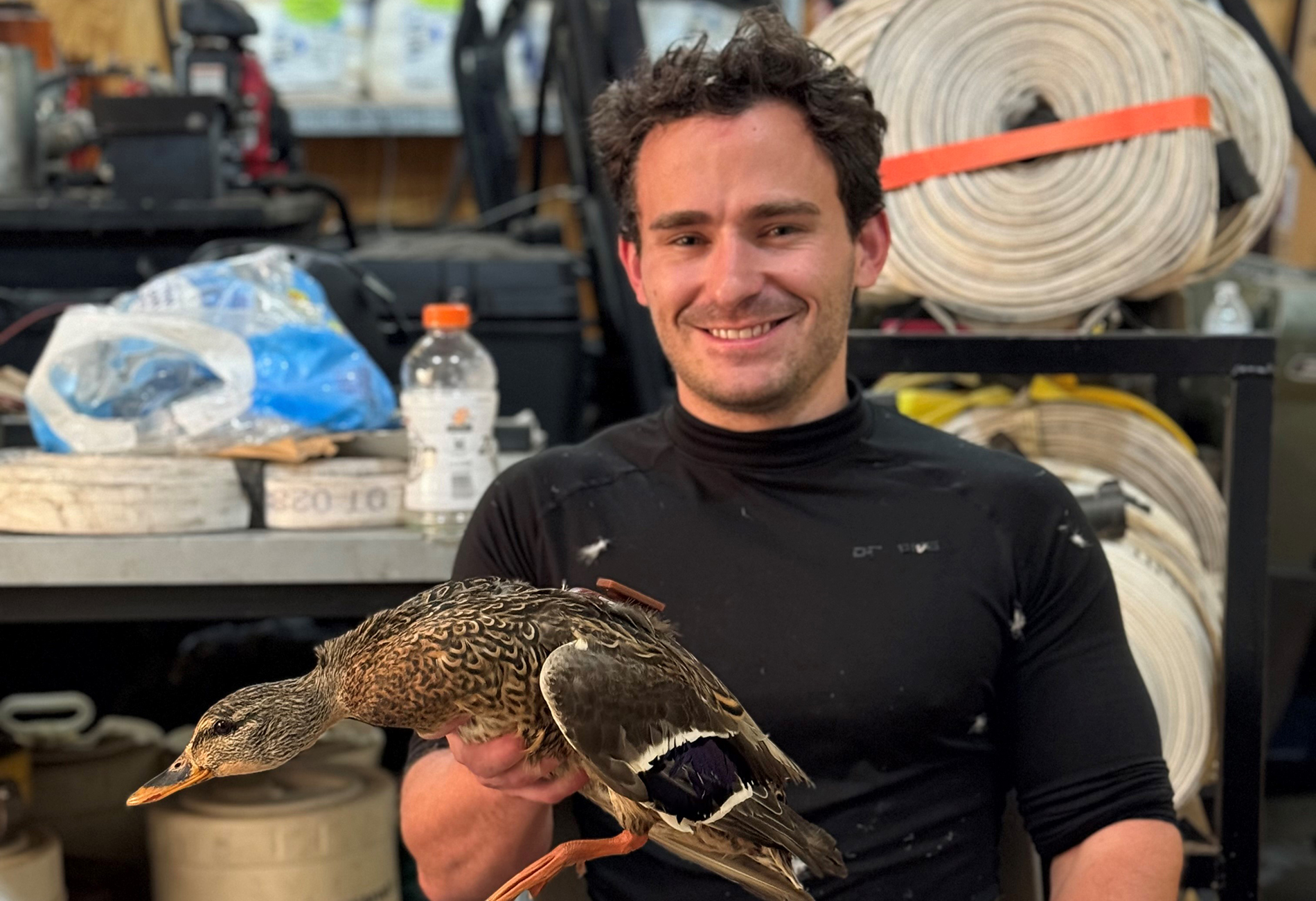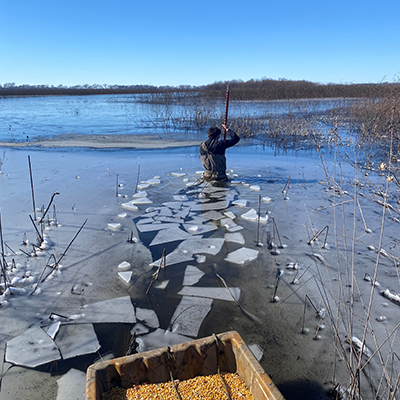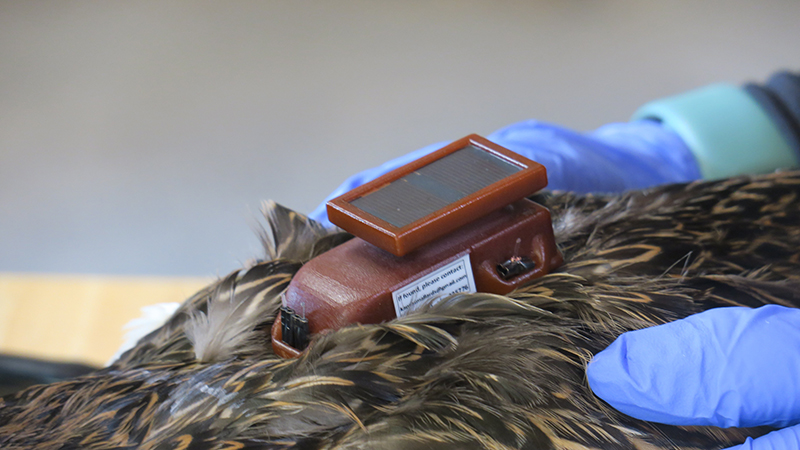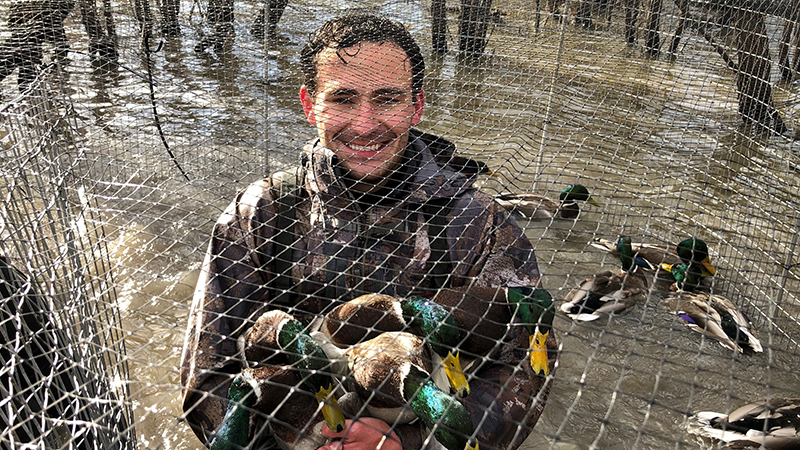
Meet Ethan Dittmer
Mallards may enter duck hunting season with a few strategies of their own.
Ethan Dittmer, a waterfowl scientist and Nebraska doctoral student, said his research this past year on the Southeast Kansas Mallard GPS project indicates the ducks are smart enough to hide from hunters.
“Mallards are incredibly capable of navigating the landscape with extreme hunting pressure safely,” he said. “What I mean by that is they don't often make random movements or flights. They know when to fly and where to go when it's safe.”
In his project’s first field season in southeast Kansas in fall and winter 2023, Dittmer observed ducks staying during the day on public lands and sanctuaries closed to hunting. At night, when waterfowl hunting was closed everywhere, the ducks moved to private hunting grounds to feed on more abundant food sources. In the morning, they returned to the safe spots.
Dittmer had hunted ducks in high school and had long suspected this waterfowl version of hide-and-seek. He had also observed such duck behavior in his master’s research in Arkansas and now sees it in his current research.
“It's probably my favorite aspect of the mallard waterfowl research I've done before is kind of the interplay of hunting with their behavior,” he said. “It's just really impressive to me just how smart they can be of navigating those landscapes.”
While ducks and mallards have been extensively researched elsewhere, Dittmer said the southeast corner of Kansas hasn’t had research in the area, even though it’s well known as good for duck hunting. He said his research is looking at how ducks, particularly mallards, select habitats, use public versus private lands, move within the area and migrate to and from it.
He has upcoming field seasons in fall and winter 2024 and 2025, with his research expected to inform state management of waterfowl in the area. He said the State of Kansas has conservation dollars that can be sent to northern areas where mallards nest.

“If the state can support mallards that they know come to southeast Kansas, that's probably the best use of where to send their dollars for conservation on the nesting grounds,” he said.
Mallards generally migrate in the fall from the Prairie Pothole Region, found mainly in North Dakota, South Dakota, Minnesota and the bordering Canadian provinces. They migrate to southern states, with Arkansas being a popular wintering spot, and return north in the spring to nest and have young.
He said his research team of Nebraska professor Mark Vrtiska, Jay VonBank, U.S. Geological Survey, and Tom Bidrowski, the statewide Kansas waterfowl biologist, viewed Kansas as being only the central part of the mallards’ migration and expected most ducks to continue south in winter.
“We really didn't see that,” Dittmer said. “All in all, the mallards stayed there as long as they could. We had a very significant cold snap in early January. That did push out, I'd say, roughly half of our mallards, but it was abnormal, and a very strong, abrupt, cold snap that came through. So, all in all, we were kind of surprised, generally, that the mallards that we capture here stayed for as long as they could.”
This mallard research requires grit, when what Dittmer calls an “easy” workday can start before sunrise and go until 2 a.m.
On a typical day last winter, Dittmer arrived at a wetland near sunrise to band about 300 ducks caught in swim-in traps. He brought along a research technician, 10 volunteers, poultry crates and canoes and sleds to capture the ducks and haul them back to his workshop.

Once at the workshop, the volunteers banded the male mallards, took blood samples from them and recorded data, like age. Dittmer and the research technician, Lauren Jackson, performed surgery on the female mallards. They inserted hollow tubing under the birds’ skin on their back and sewed 20-gram GPS transmitters to them through the tubing. After outfitting mallards with the high-tech backpacks, they released them . . . finishing around 2 a.m.
“The days we catch the ducks, that’s easy,” Dittmer said. “Beforehand, there's so much more time and effort involved to get ready for those days to be possible.”
He drove more than 15,000 miles among the three project sites from October into December. While all three sites are in Southeast Kansas, two are almost three hours apart. Although a student, Dittmer doesn’t take classes in the fall while working on the project.
“Long story short, there's really no option other than me being in Kansas full time during the fall and winter to get the project done, which I'm not complaining about,” he said. “I love it, but it is a lot of work.”
The teams he led in the first season banded 728 mallards and attached transmitters to 54 female mallards. The transmitters perform off solar power and record location readings every 15 minutes. They also transmit accelerometer readings, which tell the tilt and angle of the mallard and, thus, indicate activities. Every 12 hours, the transmitters collect all data and send it to Dittmer through cell towers.
Since this research takes place during hunting season and transmitters cost about $1,200, Dittmer puts an email address on all transmitters and requests that hunters who harvest a marked mallard email him and turn the transmitter in. He will give hunters an empty replica of the transmitter for mounting and provide a map of the mallard’s travels.
Three hunters turned in transmitters on mallards they harvested in the 2023 season.
Hunters typically view harvesting a duck with a transmitter on it as a trophy, Dittmer said, because of the rarity and scarcity of that happening, with millions of mallards flying unmarked.
“It's not ideal when they get harvested, but sometimes you could definitely make someone's day, for sure,” he said.
He credits hunters with the mallards’ unendangered status.
“Duck hunters, through license sales and other fees, have been the ones that have supported waterfowl conservation through research, habitat acquisition and management,” he said. “It's kind of unique where, even though hunters are the ones harvesting these birds, if it wasn't for hunters, the conservation would have not taken place.”
Dittmer said he sees his work as a way to give back to waterfowl conservation and duck hunters.
“It's a way for me to link duck hunting and wildlife conservation together through what I do, my research, and that's the gist of why I do what I do,” he said. “It's fulfilling for me.”
— by Ronica Stromberg
